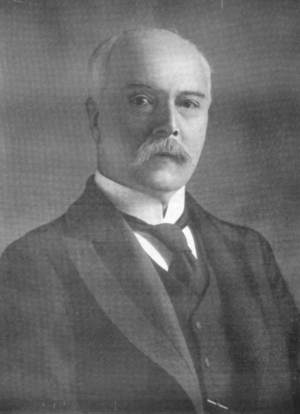George Clarke, 1st Baron Sydenham of Combe facts for kids
Quick facts for kids
The Lord Sydenham of Combe
|
|
|---|---|
 |
|
| 16th Governor of Bombay | |
| In office 18 October 1907 – 5 April 1913 |
|
| Monarch | Edward VII (1907–10) George V (1910–13) |
| Preceded by | Lord Lamington |
| Succeeded by | Lord Willingdon |
| 10th Governor of Victoria | |
| In office 28 September 1901 – 24 November 1903 |
|
| Premier | Sir Alexander Peacock (1901–02) William Irvine (1902–03) |
| Preceded by | The Lord Brassey |
| Succeeded by | Sir Reginald Talbot |
| Personal details | |
| Born | 4 July 1848 Lincolnshire, England |
| Died | 7 February 1933 (aged 84) London, England |
| Military service | |
| Allegiance | United Kingdom |
| Branch/service | British Army |
| Years of service | 1868–1901 |
| Rank | Colonel |
| Battles/wars | Egyptian Expedition Mahdist War |
| Awards | Knight Commander of the Order of St Michael and St George |
Sir George Sydenham Clarke, 1st Baron Sydenham of Combe (born July 4, 1848 – died February 7, 1933) was an important officer in the British Army. He also worked as a colonial administrator, helping to govern parts of the British Empire. Later in his life, he wrote a novel.
Contents
Life and Career
Early Life and Education
George Clarke was born in Lincolnshire, England. He went to school at Haileybury, Wimbledon, and the Royal Military Academy, Woolwich. These schools helped him prepare for a career in the military.
Military Service
Clarke joined the Royal Engineers in 1868. This is a special part of the army that deals with engineering and construction. He served in the Egyptian Expedition and later in the Sudan expedition.
From 1885 to 1892, Clarke worked as secretary for the Colonial Defence Committee. This group helped plan how to protect Britain's colonies. For his work, he was honored as a Knight Commander of the Order of St Michael and St George (KCMG) in 1893. He also helped improve how the Navy and Army worked together.
Working as a Governor
Clarke left the army in 1901. He was then chosen to be the Governor of Victoria in Australia. He started this job in December 1901 and served until 1903.
Later, he became the Governor of Bombay in India, serving from 1907 to 1913. A statue of him stands in Bombay, near the Institute of Science College. In 1913, he was given the title Baron Sydenham of Combe. This title was named after an old family home in Devon, England.
Ideas on Fortification
In 1892, Clarke wrote a book called Fortification: Its Past Achievement, Recent Development and Future Progress. This book greatly influenced how Britain thought about military defenses.
Clarke believed in the 'Blue Water' idea. This meant he thought the Royal Navy (Britain's navy) was the most important defense against invasion. He felt that building huge, permanent forts in peacetime was a waste of money. Instead, he suggested using smaller, cheaper, and quicker-to-build defenses made of earth.
His ideas were partly based on the successful defense of Plevna in 1877. Turkish forces used simple earth defenses and modern rifles to hold off attacks. Also, in 1882, Clarke studied the damage to forts in Alexandria after a heavy attack by the British Navy. He found that the earth defenses were barely damaged.
Clarke's ideas about strong, simple earth defenses proved to be very true during the First World War (1914–1918), where trench warfare became common.
Views on Winston Churchill
Lord Sydenham sometimes disagreed with Winston Churchill, who was a famous British politician. In 1916, Sydenham wrote letters to The Times newspaper. He argued that Churchill's ideas about the German Navy were not quite right. Churchill believed the German fleet was already effectively blocked. Sydenham, however, thought it was important to seek a big victory over the German Fleet.
Later, Lord Sydenham was one of several military writers who criticized some of the facts and figures in Churchill's book, The World Crisis. They published essays pointing out what they saw as mistakes in the book.
Writing a Novel
In 1891, George Clarke published a fictional book called The Last Great Naval War. An historical retrospect. By A. Nelson Seaforth. Sixth thousand. This book was a made-up story about a war between Britain and France, set in the year 1930.
Personal Life
On June 1, 1871, George Clarke married Caroline Emily. She passed away in 1908. They had one child, Constance Violet Clarke, who was born in 1879 and died in 1909.
In 1910, he married Phyllis Angelina Reynolds. Lord Sydenham of Combe died at his home in London in February 1933, at the age of 84. Since he had no surviving children, his title ended when he died. He was cremated at Golders Green Crematorium.

